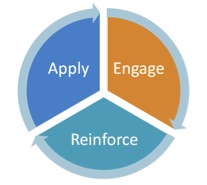The corporate training and learning environment has changed significantly over the past 10 years. With emerging technologies such as web-based learning, virtual classrooms and mobile learning, the “classroom” has expanded beyond the walls of a training room. Training organizations are an added expense that companies inherit, with little return on investment for ensuring that learning and learning concepts are understood and applied appropriately to the job. The blended learning model enables companies to create an optimal learning environment -- combining self-paced eLearning with live instructor-based training. Using a “hybrid” approach -- eLearning courses promote new or routine concepts or processes and live instructor delivery re-enforces those topics with a “real-world” personalized learning approach to differentiate topics across multiple learning groups. This hybrid model has 3 areas of focus: engage, reinforce and apply.
- Engage: Engage the learner with new processes, procedures and ideas through computer-based training (CBT) or eLearning modules. This phase provides the learner with foundational understanding of the new concept, while answering the basic questions of “What?”, “Why?” and “How?” this new information will be used.
- Reinforce: Reinforce the learning experience through live instructor-led facilitation. Creating classes or courses that emulate the CBT or eLearning modules, allow the facilitator to focus on the application of new material in a “hands-on” and “scenario-based” interactive environment. Learners are able to put their new “knowledge to work” while facilitators assess the learners' ability to perform.
- Apply: Put the knowledge to work! The learner is prepared for success to integrate its new knowledge into daily work activities.
I found this model to be successful in providing standard material across multiple work groups. A training program that was “topic-based” with pre-requisites kept the learner from feeling overwhelmed, rather than providing a 2-3 weeks “fire-hose” training and not retaining the material. The ability to push small updates and “check knowledge” through interactive games and quizzes, provides a quick and easy assessment for classroom focus and topics.
By incorporating a model that allows the learner to learn material, demonstrate competency and then apply it to “real-world” activities, employees are better prepared to sell more, be more productive, receive higher customer satisfaction scores and produce higher first call resolution results.




